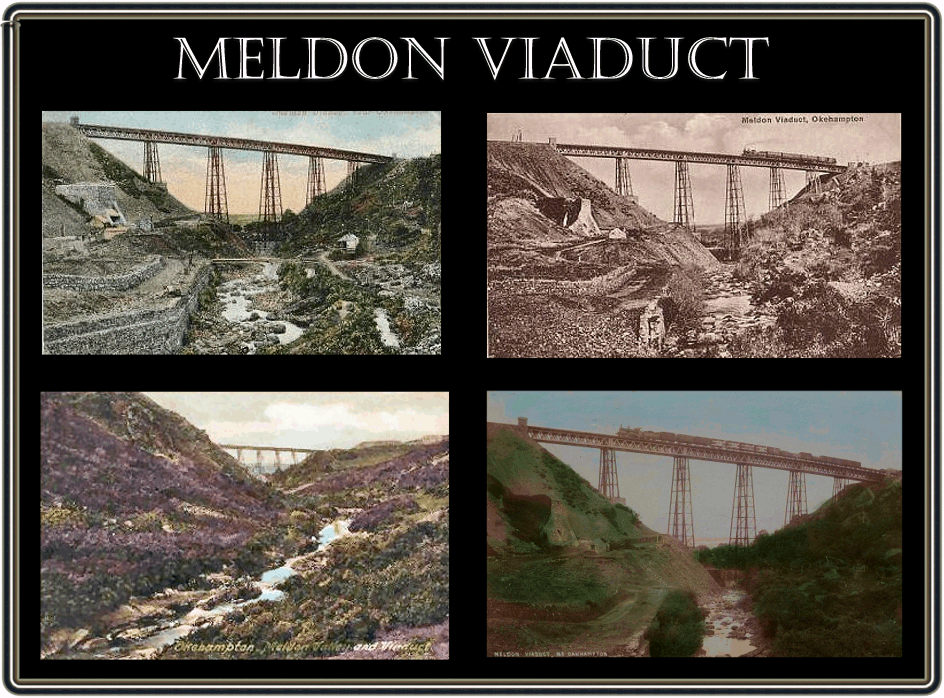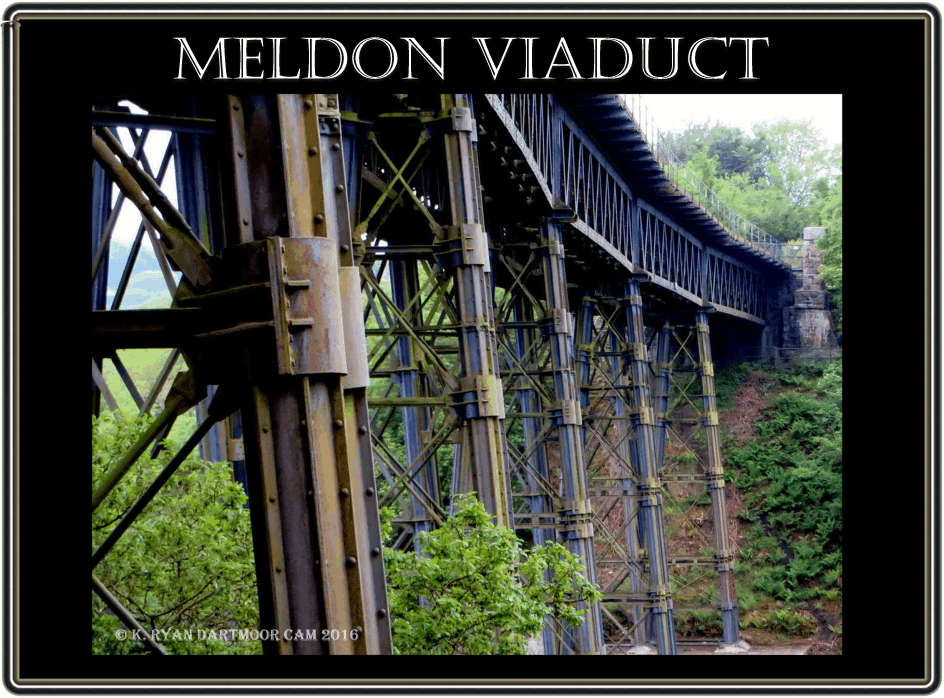
“Meldon Viaduct hung like a spider’s web spun of silver above the mists of the gorge. Arms fell from it to the darkness below, and the whole, fraught with night’s own magic, possessed a beauty of its own —a beauty higher than the inherent beauty of perfect adaptation to its purpose. The iron way floated above them, frail and delicate, like some dream-path for spirits. Yet here, transformed by that starry hour to mere staple of light against darkness, there towered a thousand tons of steel supporting a thoroughfare whereon forty thousand human souls sped yearly across the dizzy depths below.” Eden Phillpotts, The Portreeve, pp. 29 – 30.
During the 19th century the British rail network was rapidly expanding with many railway companies competing to provide passenger services and such was the case in the South-West of England. Clearly there was a need to provide train services from London into Devon and Cornwall and at the time there were two companies in competition to provide such a service. The two rivals were the LSWR (London and South West Railway) and the GWR (Great Western Railway). Unfortunately for the LSWR the GWR had already built a line from Exeter and Plymouth under the auspices of its associated SDR (South Devon Railway) subsidiary. Due to this fact the GWR were allowed to construct the southern coastal route The only option left to the LSWR was a more northerly route that meant crossing parts of Dartmoor. One of the biggest challenges on this route was that the line would have to cross the West Okement river at some point on its journey, the best solution for this was at Meldon and would require a huge structure in order to do this. The answer was a truss bridge which locally became known as either the ‘Meldon Viaduct’ or the ‘Spider Bridge’. Work on what was originally a single track railway began in 1871 under the guidance of the engineer – W. R. Galbraith with R. T. Relf, being the contractor. When the scheme was announced many said that due to the height and complexity of the construction there would be a ‘list of many disasters’. In the October of 1873 the half yearly report of the railway company noted that; “The hope which the directors had expressed at the last meeting that the railway would then shortly be opened for traffic had, unfortunately, not been realised in consequence of the state of the weather, the labour market, and the difficulty of obtaining the delivery of the iron work for Meldon Viaduct, which was the most important structure on the line. The completion of the works within a short period might now, however, be regarded as certain.” Prior to the viaduct being officially opened local reporters were invited to inspect the structure when the following report was published:
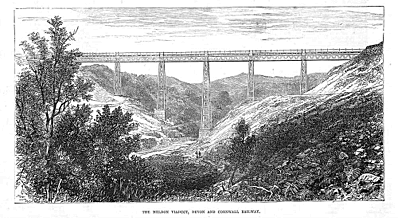
“This structure, which has been christened the Meldon Viaduct, is of novel design, and has excited no small amount of comment among the natives. It consists of six openings, or spans, of 90 feet ( 27.43 metres) each. The railway is carried on wrought iron girders 9 feet (2.74 metres) deep, constructed on the Warren principle. At each end of the viaduct the girders are supported on cast-iron cylinders filled with concrete, and surrounded by embankment, so that their duty is merely to withstand a downward pressure, all lateral movement being controlled by the earth or rather rock-work in which they are embedded. The five intermediate piers are composed of wrought-iron columns, securely braced and rivetted together, resting on bases of solid granite, to which they are firmly fastened by massive wrought iron bolts. Each pier is built up with four columns. The extreme height from the bed of the river to the rails is 152 feet (46.32 metres); and as both the girders and the piers are of open latticework, painted white, the viaduct to an inexperienced eye looks somewhat slender. It is only to the eye that any want of stability seems to present itself, for repeated tests have proved the great strength of the erection; and Colonel Hutchinson, on Friday, after trying its vibration and levels while two engines, some 120 tons in weight, passed and re-passed over it again and again, expressed himself well satisfied with the result of examination. The rule laid down by the Board of Trade is that all wrought iron bridges shall be of strength sufficient to sustain four times the greatest load which can by any possibility be brought upon them. The ironwork for the viaduct was supplied by the well-known firm of Lloyds, Foster and Company, of the Old Park Works, Wednesbury. It weighs 420 tons, and the accuracy with which the various parts are fitted together contributes materially to the solidity of the structure as a whole.” The North Devon Journal, September 17th 1874.
The track had a gradient of 1 in 77 rising towards the west and to horizontally curved at approximately 600m radii. The old postcard below shows the slight curve and the double tracks as seen in 1960, shortly before the line’s closure
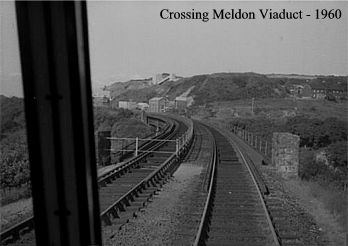
On the 6th of October 1874 the Standard newspaper reported the following; “The line of the Devonshire railway between Okehampton and Lydford which has for some time in construction, is at last completed. It has been duly inspected by Colonel Hutchinson, and was opened for general traffic on the 1st of October.” It was also noted that the route had shortened the route from London to Plymouth by 18 miles. In 1878 there was a need to increase the capacity of the line from a single to a double track and so a second viaduct was built alongside the existing one. The old track was used as the ‘up’ line and the new one as the ‘down’ line. The expansion involved the construction of an extended decking linking the two structures and the addition of extra bracing on the top of the trestle piers. The trusses were built in a railway siding and when completed were hoisted into place by two rail mounted cranes, the operation of placing each truss into position took about two and a half hours. Each ‘lift’ was carefully scheduled so that at no time was the railway’s timetable ever interfered with and trains ran as normal. The work was completed in 1879 and it was estimated at the time that the expansion project cost around £15,000 to complete.
No matter how expertly the viaduct was constructed the one factor it could never cope with was the Dartmoor weather, especially the high winds that occur in the vicinity. In the November of 1894 the morning goods train from Okehampton to Delabole had to be halted on the viaduct due the the strength of the wind. This meant that the train had to go to Meldon Junction where it detached some of the carriages. The shorter train then crossed the viaduct and returned to collect the remaining load, unfortunately it became derailed and ended up blocking the line for the rest of the day. In 1927 there were some serious worries concerning the strength of the winds so much so that a speed restriction of 20 m.p.h. was placed on trains crossing the viaduct. Over the coming years various upgrades were made to the viaduct in order to allow heavier trains to cross. In 1938 the bottom cords of the original trusses were braced, between 1939 and 1945 various strengthening works were carried out by means of weighting the tressle columns with concrete and the piers reinforced. In 1959 collars were placed around the columns and sturdier braces added.
In the April of 1966 the railway reverted to its original single track with traffic being carried across the viaduct on it’s original track. By the May of 1968 all through trains had been stopped although the line carried on being used by the Meldon Quarry. Shortly after this (1970) a concrete road was laid over the viaduct in order for construction traffic to reach the site of the new Meldon Reservoir. In 1990 the last vestiges of the line were removed, these being the tracks and the viaduct was left to the enjoy the peace and tranquillity of the moorland landscape. Well, that was until 1996 when a huge £650,000 refurbishment programme was carried out. The works included; steelwork and masonry repairs to the abutments, river bed scouring in order to protect the piers, general repainting and treatment of the woodwork. The newly restored viaduct was officially reopened in 2002 by the broadcaster, author and historian – Adam Hart Davies and now is part of the Granite Way cycle path. Since 1998 the ownership of the viaduct is now in the hands of a non-profit making – the Meldon Viaduct Company. Oddly enough Companies House list the Meldon Viaduct Company’s nature of business as being – ‘other sports activities’. If you then follow another link you are taken to www.meldonviaduct.co.uk which is a website selling shoes and clothing???
Much of the later information above was found on the Engineering Timelines webpage for Meldon Viaduct
Meldon Viaduct Miscellany.
Meldon Viaduct is one of only two wrought iron constructions of its kind in Great Britain, the other being the Ilkeston Viaduct in Derbyshire.
A fatal accident occurred in 1872 when a young lad of 18 was working sawing wood on on a stationary steam saw engine beneath the viaduct. Above him some men were taking apart a travelling crane when a piece fell off and hit the lad below. It was said that the iron part weighed in excess of six hundredweight and his death was instantaneous.
There was a near miss in 1875 a passenger train had just crossed over the viaduct when several yards of embankment slipped and blocked the line, but before a warning could be issued a good train slammed straight into the debris on the track.
In 1877 a train had just gone over the viaduct and began the climb up the incline when it crashed into a large landslide of rock and earth in the cutting, the train was a complete wreck but luckily nobody was injured.
A heavy landslip near the viaduct once again blocked the line in 1879, no sooner had this been cleared than another slip occurred which once gain blocked the line. passengers had to be transferred to other trains and all good traffic was suspended.
Whilst engaged on work to double the tracks near the viaduct in 1878 there was a serious accident. Two men had charged a hole with gunpowder and were just about to fire it when there was a premature explosion. One man was blown off his feet and sustained serious head and face injuries and was taken off the line in a trolley to Okehampton and then transported to Exeter hospital. It was thought at the time he would lose his eyesight. The other man also received injuries to his face although not so serious as those of his his work mate.
In the May of 1931 a man working on the viaduct was struck and killed by the 10.10 am. goods train which was travelling from Okehampton to Wadebridge. The unfortunate man was walking along the 6ft way when the train approached and signalled its presence, being a windy day the warning was not heard and he was hit by the train. It was not until the driver got to Halwill did he learn of the accident.
At 5.oo am. on the morning of the 13th of April 1933 the driver of a down goods train noticed that there was a fire on Meldon Viaduct. He immediately reported the fact to the signalman at Meldon Junction who then telephoned for the fire brigade. The fire was centred at a length of wooden decking on the upward track and was probably caused by a spark from the engine or a hot coal from the fire box. Until the fire brigade arrived the blaze was tackled by workers from the quarry armed with fire extinguishers. In order to tackle the fire the brigade had to take their engine across three miles of rough moorland track and then reel out thousands of feet of hose from the river below up to the viaduct. “Flames were seen licking the thick baulks of the timber in the centre of the viaduct below the railway track, and in order to reach this spot the firemen had to clamber for a distance of 100 yds along a narrow inspection plank which runs over a network of steel girders. A slip at that dizzy height would have meant a crash to certain death among the rocks below. To make matters worse, a heavy fog veiled the valley, and the task of the men was rendered additionally difficult by having to keep the hose from twisting off the planking, and at the same time maintain a sure grasp of the steel stays.” The Western Times, April 13th 1933. It took about half an hour to put out the fire and virtually no disruption to traffic.
One little aside here, apparently the Meldon Quarry areas was renown for its large population of snakes with reports of 39 being killed in one day. In 1888 the following story was published; “My first experience of them was on visiting Meldon Viaduct, the in the course of construction, to find two navvies, had each two or three in their hats, which they would place on their heads, or to allow the reptiles to creep in at the breast of their shirts and out at the wrists.” Unfortunately there is no mention as to whether they were grass snakes or adders?
There is a 4.5 mile walk called the ‘Meldon Viaduct Circuit’ which takes in part of Prewley Moor and Sourton Down before picking up the old railway line and looping around through Meldon Quarry and then crossing over the viaduct. Details of which can be found – HERE.
If you fancy getting up close and personal with Meldon Viaduct and have £25 to spare then you can experience a freefall abseil known as the ‘Big Oke Abseil’ which goes all the way down to the river below. Unfortunately in the July of 2017 a 12 year old boy had to be rescued after falling and injuring his leg whilst abseiling off the viaduct. His fall ended up with him being stuck some two metres up on the inspection gantry. Fire crews from Okehampton and Hatherleigh, along with a special rescue team from Camels Head and Dartmoor Search and Rescue team eventually rescued the boy who was found to have a broken knee.
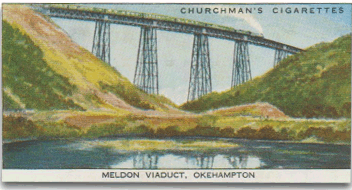
In 1937 Churchman produced a set of 50 cigarette cards called ‘Wonderful Railway Travel’ which depicted various railway bridges, one of which was Meldon Viaduct. Today that card has a catalogued price of £25 and normally fetches around £15. By chance I found the one above on Ebay which I bought for £1
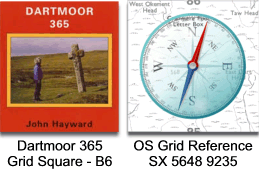
“This impressive viaduct was built during the 1870s to carry a railway from Okehampton to Tavistock, the former London & S. W. Railway. It is about 180 yards long and stands 150 feet above the river. The line was closed in the 1960s, but the viaduct is not open to the public.” Hayward, J. 1991. Dartmoor 365. Curlew Publications. p.17.
 Legendary Dartmoor The many aspects past and present of Dartmoor
Legendary Dartmoor The many aspects past and present of Dartmoor

